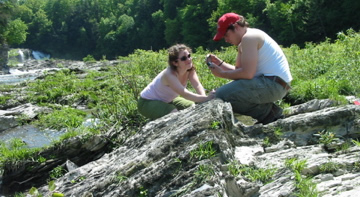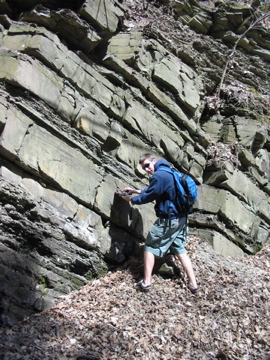
Structure and Tectonics
| |
| Prof. Garver |
| Env. Science & Policy |
| Geosciences |
| Field Science at Union |
| Union |
| Fold and faults record ancient tectonic collisions |
Structural geology and Tectonics is a mid-level course aimed at the identification and understanding of mesoscopic structures (outcrop-scale) and their relationship to large-scale structures (regional) and, ultimately, tectonic settings. The focus of the course is practical rather than theoretical and most of the lab exercises are aimed at measuring, representing, and understanding the kinematics (movement history) of deformed rocks. Although the lectures are of a more-or-less traditional format, the focus of the lab exercises is on the structural evolution of eastern New York. The field exercises include examining joint patterns, mapping and determining the slip on a normal fault, simple fold and cleavage analysis, complex folding and the Hansen slip-line analysis, flattening and phacoid development in a structural mélange, and the relationship between folding and thrusting. All research projects involve examining rocks in the field, collecting data, manipulating and representing the data, and finally, interpreting the data in coherent, well-written field reports. The culmination of the course and these lab reports involves a final report in which the timing and kinematics of this area are discussed using data that the students have collected. Who should take this course? This is a core course for the major in the Geosciences, but Biology and Envvironmental Science students commonly take this course. It is an excellent introduction to observation, data collection, and report writing in a field science. There are weekly field projects that are aimed at understanding the structural evolution of this part of NY State. Prerequisite: Any geology course numbered 200 or higher, or permission of the instructor; weekly lab; This is a WAC course. Offered: Every SPRING Term |
Textbook:

Earth Structure: An Introduction to Structural Geology and Tectonics
by Ben A. Van Der Pluijm, Stephen Marshak
ISBN-10: 039392467X
ISBN-13: 978-0393924671
| Class is outside today | ||

Measuring fractures related to extension |
||